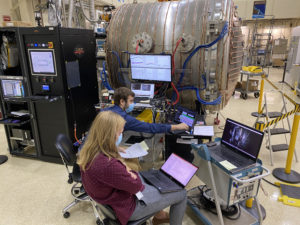Hingham, MA. June 16, 2021 – Dragonfly, the ambitious NASA rotorcraft mission to explore Saturn’s moon Titan, recently tested its surface sampling system. These critical tests were performed under the atmospheric pressure and temperature range the craft will encounter on Titan.
While exploring Titan, Dragonfly will encounter atmospheric pressure of 1.5 times that on earth, while working in temperatures as low as -181 °C. Dynavac worked with mission specialists at Johns Hopkins University’s Applied Physics Lab (APL) to build a chamber replicating these conditions. The Titan Pressure Environmental Chamber (TPEC) is a custom 5 foot diameter by 8 foot long test system.

Engineers from Honeybee Robotics using the Dynavac chamber to test Dragonfly’s Pneumatic Transfer System. Image Credit: Honeybee Robotics
Last November, a team from Honeybee Robotics spent three weeks testing their Pneumatic Transfer System prototype in the TPEC. Honeybee’s innovative system takes advantage of the atmospheric pressure and low gravity of Titan to essentially vacuum surface soil samples into Titan’s science instrumentation package for analysis. Testing the system on simulated Titan materials under that moon’s environment was a crucial milestone for the mission.
Dynavac is proud to be supporting NASA, APL, and Honeybee Robotics on this very exciting mission.
Learn about the mission here; and read more details on the successful test of Honeybee’s Pneumatic Transfer System here.
